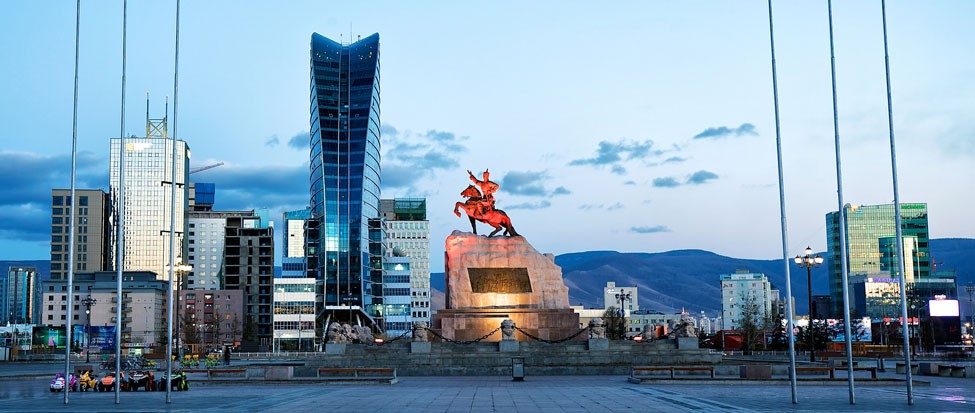

Sükhbaatar Square is the central square of Mongolia's capital Ulaanbaatar. The square was named for Mongolian's revolutionary hero Damdin Sukhbaatar shortly after his death in 1923. The square's name was changed to Chinggis Square in 2013 in honor of Genghis Khan, considered the founding father of Mongolia, but the original name was restored in 2016. The center of the plaza features an equestrian statue of Damdin Sukhbaatar, while a large colonnade monument dedicated to Genghis Khan, as well as to Ögedei Khan and Kublai Khan, dominates the square's north face directly in front of the Government Palace.
The Zaisan Memorial is a memorial in the southern area of the Mongolian capital of Ulaanbaatar that honors allied Mongolian and Soviet soldiers killed in World War II. Located on a hill in the southern part of the city, the memorial features a circular memorial painting that depicts scenes of friendship between the people of the USSR and Mongolia. The mural depicts scenes such as Soviet support for Mongolia's independence declaration in 1921, the defeat of the Japanese Kwantung Army by the Soviets at Khalhkin Gol on the Mongolian border in 1939, victory over Nazi Germany and peacetime achievements such as Soviet space flights including the flight of Soyuz 39 which carried the first Mongolian into space, Jugderdemidiin Gurragchaa. After driving to the uppermost parking lot on the hill, visitors must make a climb of three hundred steps before reaching the monument and mural. (612 steps, if they start at the base of the hill.) Those who make the climb are rewarded with a panoramic view of the entire city of Ulaanbaatar in the valley below, as well as the Tuul River flowing past the city. In 2003, a tank memorial, which previously had been located on a crossroads between Zaisan and the city center, was moved to the foot of the hill. It features a Soviet tank from a brigade paid for by the Mongolian people. The tank memorial includes a map showing the route the brigade took from Moscow in 1943 to its participation in the fall of Berlin in 1945. Zaisan is a popular meeting point for school outings and graduation festivities.
The Gandantegchinlen Monastery is a Mongolian Buddhist monastery in the Mongolian capital of Ulaanbaatar that has been restored and revitalized since 1990. The Tibetan name translates to the "Great Place of Complete Joy". It currently has over 150 monks in residence. It features a 26.5-meter-high statue of Avalokiteśvara. It came under state protection in 1994. The monastery was constructed by order of the 5th Jebtsundamba Khutuktu in 1809. The first temple was the Gungaachoilin Datsan. Only one wooden pillar remains from this temple. In 1838, the Gandantegchenlin Temple was built along with the private residence of the Jebtsundamba Khutuktu. The 13th Dalai Lama stayed in the residence in 1904. In 1840, the Vajradhara Temple was built. In 1869, the Zuu Temple was built. In 1913, the tall Avalokiteśvara temple was built. In 1925, the temple for keeping the remains of the 8th Jebtsundamba Khutuktu was built. It is now the monastery library. In the 1930s, the Communist government of Mongolia, under the leadership of Khorloogiin Choibalsan and under the influence of Joseph Stalin, destroyed all but a few monasteries and killed more than 15,000 lamas[citation needed]. Gandantegchinlen Khiid monastery, having escaped this mass destruction, was closed in 1938, but then reopened in 1944 and was allowed to continue as the only functioning Buddhist monastery, under a skeleton staff, as a token homage to traditional Mongolian culture and religion. With the end of Marxism in Mongolia in 1990, restrictions on worship were lifted.
The National Museum of Mongolia formerly the National Museum of Mongolian History is located in Ulaanbaatar. This museum is a cultural, scientific, and educational organization, which is responsible for the collection, conservation and interpretation of the objects under its curation. The first museum in Mongolia, the Mongolian National Museum (now the Mongolian Natural History Museum), was established in 1924 and became the basis for other museums, including the National Museum of Mongolian History. Russian scholars, such as Pyotr Kozlov, V. I. Lisovskii, A. D. Simukov, and the American researcher Roy Chapman Andrews contributed to the museum's early collections and exhibits. The modern National Museum of Mongolian History was established after the merger of the historical, archaeological and ethnographical departments of the State Central Museum and the Museum of the Revolution in 1991. It is now located in a facility built for the Museum of the Revolution, which was founded in 1971. The National Museum of Mongolia is currently recognized as one of the leading museums in Mongolia. The significant responsibility for preserving Mongolian cultural heritage therefore lies with the museum. It is also responsible for developing museological guidelines for museums in the nation. Exhibitions cover prehistory, pre-Mongol Empire history, Mongol Empire, Mongolia during Qing rule, ethnography and traditional life, and twentieth-century history. The ethnographic collection has significant displays of the traditional dress of various Mongolian ethnic groups and of snuff bottles. Most exhibits have labels in both Mongolian and English. The museum publishes one or more issues of its in-house journal each year, with articles in Mongolian and foreign languages, including Russian and English.